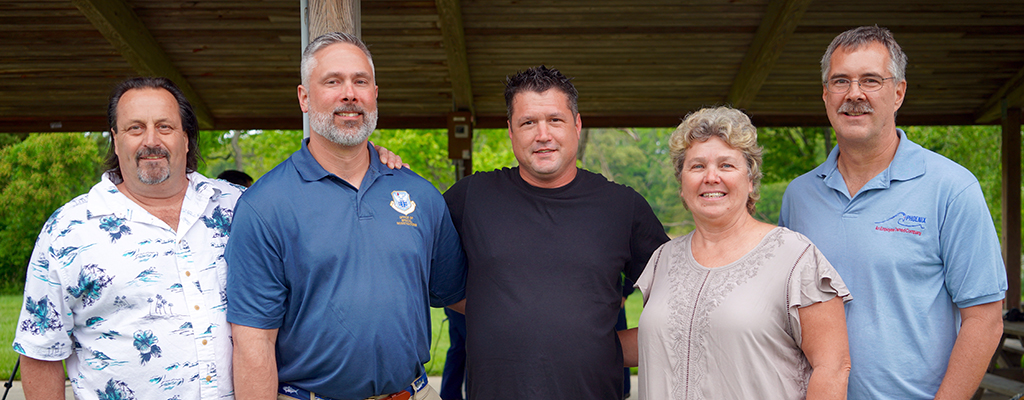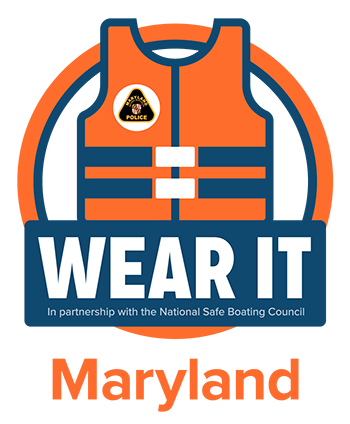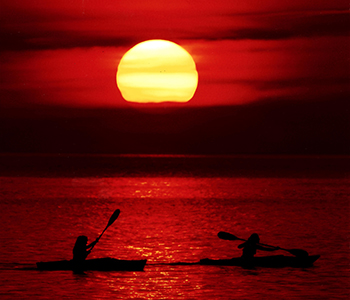Living Proof: Kayaker’s survival validates safety measures

From left: Mark Marra, Bill Walls, Sean Danielson, Lana Lohe, Robert Lohe; by Candy Thomson
With darkness approaching and the numbing cold of the Chesapeake Bay invading his bones, Sean Danielson knew his chances of seeing another dawn were slim.
Bobbing in the bay next to his swamped kayak, his eyes swept the horizon. Freighters on their way to Baltimore were too far away to hail and the pleasure boats that normally swarm the mouth of the West River in summer like bees around a hive were still swaddled in their winter shrink wrap.
“The sun was still above the horizon, but I knew it wouldn’t be long before it disappeared,” recalls Danielson of his predicament April 18, 2018. “I don’t know how much longer I could have gone on.”
But as dire as his circumstances were, Danielson had several things going for him. He was wearing a life jacket. He stayed with his neon-green boat. He remained calm. And clutched in his hand, he had a whistle.
He tried bailing out his boat with a small cup. He waved his paddle. He blew his whistle.
“I just didn’t sit there and wait to die,” he says.
In 2016, 701 people perished in boating accidents across the nation, the highest number since 2011. Approximately 75 to 80 percent of those deaths were drownings, many of which could have been prevented had the victim been wearing a life jacket.
An aggressive education and outreach campaign last year by the Maryland Natural Resources Police reduced the number of fatalities in the state to nine after reaching a 20-year high in 2015, when 21 people died. Yet sadly, Maryland mirrors the national trend when it comes to life jackets. Of the 77 people who died since the start of the 2013 boating season, only nine were wearing life jackets.
 “The numbers don’t lie. Life jackets save lives,” says Lt. Robert Ford, the head of the boating safety education unit. “Life jackets buy you time until help arrives.”
“The numbers don’t lie. Life jackets save lives,” says Lt. Robert Ford, the head of the boating safety education unit. “Life jackets buy you time until help arrives.”
Danielson, 44, an angler and veteran paddler, always wore his, even in shallow waters. But this trip was different.
With a new depth finder attached to the boat, Danielson launched from Shady Side at about 3 p.m., determined to find a deep underwater ledge where the fish were likely to be. He started paddling toward the mouth of the West River and then turned north and into the bay itself.
“I had been in the kayak hundreds of times, but never in the bay and never that deep,” he says.
A wave swamped his boat and Danielson found himself struggling in 47-degree water, far from shore. It was about 5:30 p.m. He fought the temptation to start swimming toward land.
“For whatever reason, I stayed calm,” he recalls. “I knew that being fully dressed it would be a cumbersome swim. My best odds were staying with the kayak.”
At that water temperature, expected survival time is 1-3 hours.
Just before 8 p.m., Robert and Lana Lohe of Edgewater were returning home from a cruise to the Bahamas aboard their 36-foot sailboat, Our Diamond. In the waning daylight, Robert Lohe thought he saw a patch of grass about a quarter-mile away and grabbed his binoculars for a better look. His wife thought it was a piece of carpet adrift.
Then, they heard a whistle.
Maneuvering closer, the couple saw Danielson waving his arms and shouting, “Don’t leave me. Don’t leave me.”
They circled several times and finally got Danielson—stiff and blue—to their boat’s ladder and then onto the transom. Once they wrestled him aboard, they wrapped him in a blanket and called for help, knowing a powerboat could get the victim to shore faster.

Kayakers; by Gary Marine
Bill Walls was testing his new 29-foot fishing boat, Rise and Shine, when he and Mark Marra heard the call on Channel 16 and saw the Lohes’ sailboat in the distance. Racing to the scene, they pulled up behind the sailboat and assessed the situation.
“He was in bad shape. He was in and out of it,” Walls says of Danielson. “We kept saying, ‘Hang on.’”
Transferring a hypothermic Danielson into his powerboat, Walls began the run to the Rhode River Marina while Lohe radioed information to first responders. After being in the water for more than two hours, Danielson had a body temperature of 82 degrees—dangerously low.
He was treated with warming blankets at a local hospital and returned home. Now, Danielson hopes to pay it forward by telling his story and urging people to follow simple safe boating tips. After all, Danielson says, he’s living proof that they work.
His rescuers agree.
“The No. 1 thing was the life jacket,” says Lohe. “He was able to wave his arms and blow his whistle because he had a life jacket on. If he hadn’t stayed with the kayak, we never would have seen him. Without those things, he simply would have been gone.”
Article by Candy Thomson—Natural Resources Police public information officer. Appears in Vol. 21, No. 3 of the Maryland Natural Resource magazine, summer 2018.


 1-888-373-7888
1-888-373-7888 233733
233733